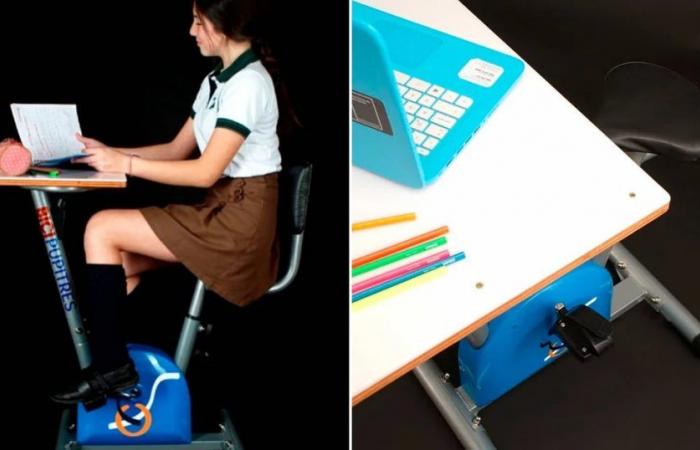The bikebanks They are an innovative combination of a school desk with fixed bicycle pedals. This fusion allows students to exercise while actively participating in academic activities. The main idea behind bike banks is improve both physical health and students’ ability to concentrate and learnfacilitating a more dynamic and attractive environment for learning.
Born from the need adapt educational methods to the new realities of students, especially those with difficulties maintaining attention or controlling their hyperactivity, these desks seek to offer an effective and multifunctional solution. Additionally, they integrate physical activity into the academic environment without having to leave the classroom, keeping students energized and focused on their tasks.
Different studies and projects at an international level have endorsed its effectiveness, proving to be especially beneficial for students with Attention deficit disorder and hyperactivity (ADHD). The implementation of these desks has been a collaborative effort between educational authorities, parents and specialized designers.
In Mexico, the Secondary School No. 24 Guillermo Prieto, located in San Nicolás, Nuevo León, has been a pioneer in the implementation of bike banks. The Nuevo León Education Secretariat acquired 233 of these innovative desks for seven first-year high school groups. The director of the campus, Sanjuanita García Marroquín, highlighted that both parents and students have welcomed this new modality, observing improvements in the academic performance and energy of the students.
On the other hand, in Argentina, sixth year students of Leonardo Da Vinci Institute of Río Cuarto, Córdoba, have also developed their own version of bike banks. Within the framework of the subject of science, technology and ethics, they designed these desks specially adapted for students with ADHD. Mateo Cambria, one of the students in charge of the project, highlighted that “For certain cases within the broad spectrum of this condition, it is extremely useful. However, it is not always the ideal option, given that each individual has unique and different learning patterns.”
In both cases, bike banks have been shown to be a promising solution, not only to improve attention and behavior in the classroom, but also as an important step towards a more inclusive and adaptive education to the individual needs of students.
He Attention Deficit Hyperactivity Disorder (ADHD) It is a neurobiological condition that affects children, adolescents and in some cases, adults. It is characterized by three main symptoms: inattention, hyperactivity and impulsivity. Inattention can manifest itself in difficulties staying focused, following instructions, and completing tasks.
Hyperactivity involves a level of physical activity greater than expected for the child’s age, including constant movement and an inability to sit still. Impulsivity translates into behaviors that occur without prior reflection, such as interrupting or acting without considering the consequences.
According to the National Institute of Mental Health (NIMH) of the United States, ADHD is one of the most common neurodevelopmental disorders in childhood. Children with ADHD often face challenges in school and in their social interactions. The exact cause of ADHD is not completely known, but it is believed to involve a combination of genetic and environmental factors, and differences in brain structure and function. Research has shown that it is more common among children who have relatives with the same disorder, suggesting a component hereditary.
The diagnosis and treatment of ADHD often requires a multidisciplinary approach that may include paediatricians, psychologists and neurologists. Treatment strategies can vary but commonly include a combination of medications and behavioral therapy. According to the American Psychiatric Association (APA), effective treatment of ADHD can considerably improve the quality of life of the affected person, helping them manage their symptoms and developing skills to improve their school performance, social relationships, and emotional well-being.}
Bike banks are especially useful for students with Attention Deficit Hyperactivity Disorder (ADHD) due to their ability to integrate physical movement and school activities. ADHD is characterized by persistent inattention, hyperactivity, and impulsivity, factors that make it difficult to concentrate and behave appropriately in a traditional classroom environment. Bike benches allow students to channel their excessive energy while remaining in their seats, facilitating a better care and reduction of disruptive behaviors.
The constant movement of the pedals offers a way to release pent-up energy, which is crucial for students with ADHD. Several studies have indicated that physical activity can improve the brain’s executive function, which includes skills such as planning, organization and emotional regulation.
Furthermore, these artifacts promote a greater inclusion in the classroom, by offering a tool that adapts to the specific needs of these students. The implementation of bike banks in the educational environment creates a more understanding and flexible environmenthelping to normalize the additional movement needs of students with ADHD and reducing the stigma associated with the disorder.






